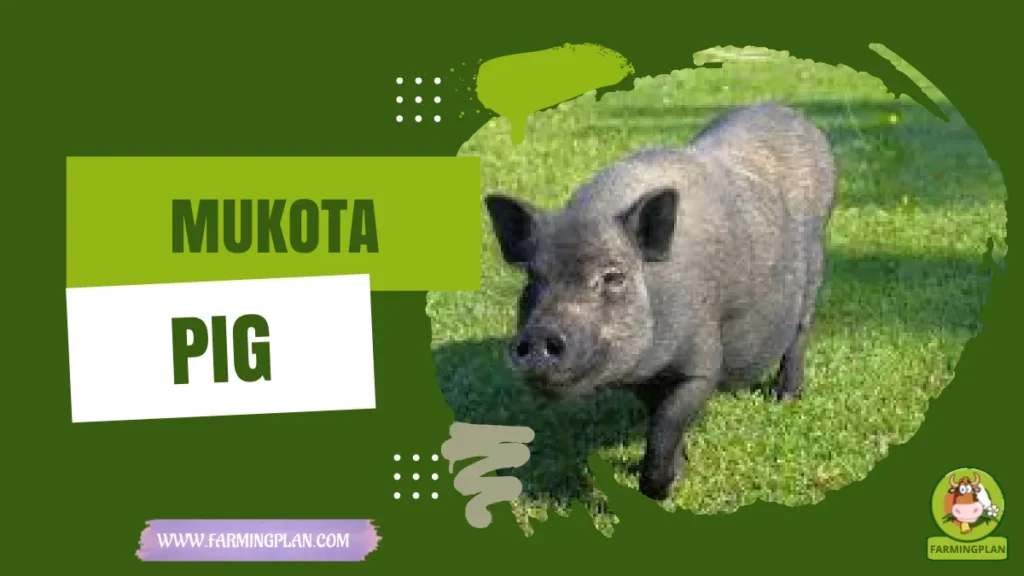If you’re looking for a reliable dairy breed with top-tier milk and a calm nature, the Brown Swiss Cow is a fantastic choice. As a farmer, I’ve worked with many cattle, but Brown Swiss stand out for their rich, high-protein milk and gentle temperament. Originating from Switzerland, they’re ideal for both seasoned dairy farmers and newcomers. Their strength, long lifespan, and friendly personality make them easy to manage and perfect for producing cheese. In this guide, I’ll share everything I’ve learned—from their history and traits to feeding tips, farming advice, and where to find one.
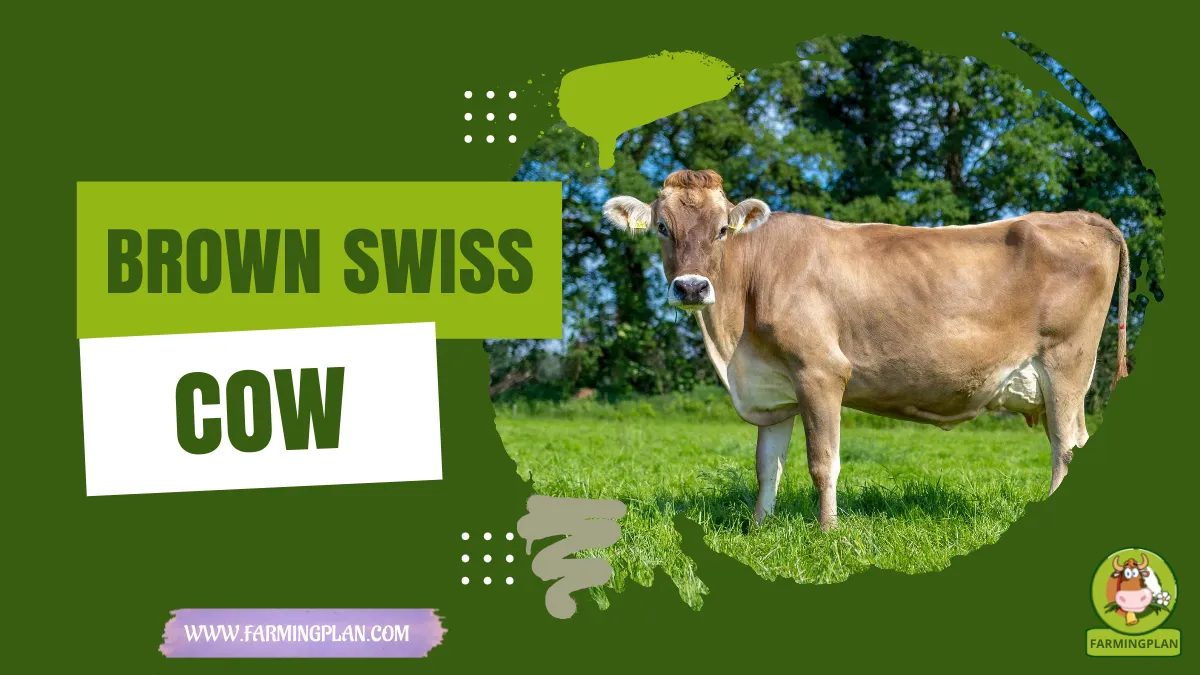
History & Origin of the Brown Swiss Cow
In Switzerland, in the mountains called the alps, this breed appeared and has endured for many years. In the local language, the Brown Schwyzer is called the Schwyzer and it was created to adjust to the region’s steep hills and lots of rain. Bos Municipals have been continually bred since ancient times, with records going back to 4000 B.C. They were bred for both milk and beef which shows how hardy they are. As years went on, Swiss farmers chose animals that produced he most milk and had the heartiest hooves, causing the modern Brown Swiss breed to develop.
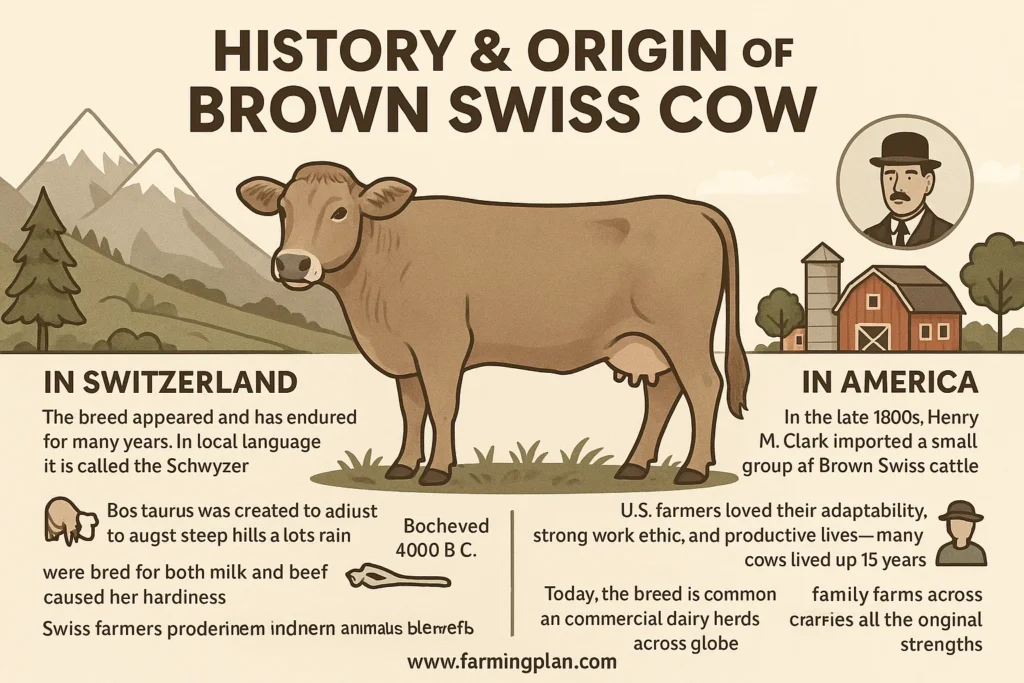
In the late 1800s, Brown Swiss cattle made their way to America thanks to Henry M. Clark, who imported a small group that quickly gained attention. U.S. farmers loved their adaptability, strong work ethic, and productive lives—many cows lived up to 15 years. Today, the breed is common in commercial dairy herds and family farms across the globe. The American Brown Swiss has developed slightly from its European ancestor but still carries all the original strengths, making it a worldwide dairy superstar.
Read More: Jersey Cattle: Incredible Milk Producers You’ll Love
Brown Swiss Cow Characteristics
Brown Swiss cattle are known for their large, muscular build and striking appearance. They range in color from light brown to dark chocolate, often with white muzzles and a creamy dorsal stripe. Their eyes show off long lashes, giving them a friendly, almost human look. But it’s not just about looks—these cows have strong, correct feet, ideal for mountainous or uneven terrain. They are also larger than most dairy breeds, weighing anywhere from 1,200 to 1,800 pounds.
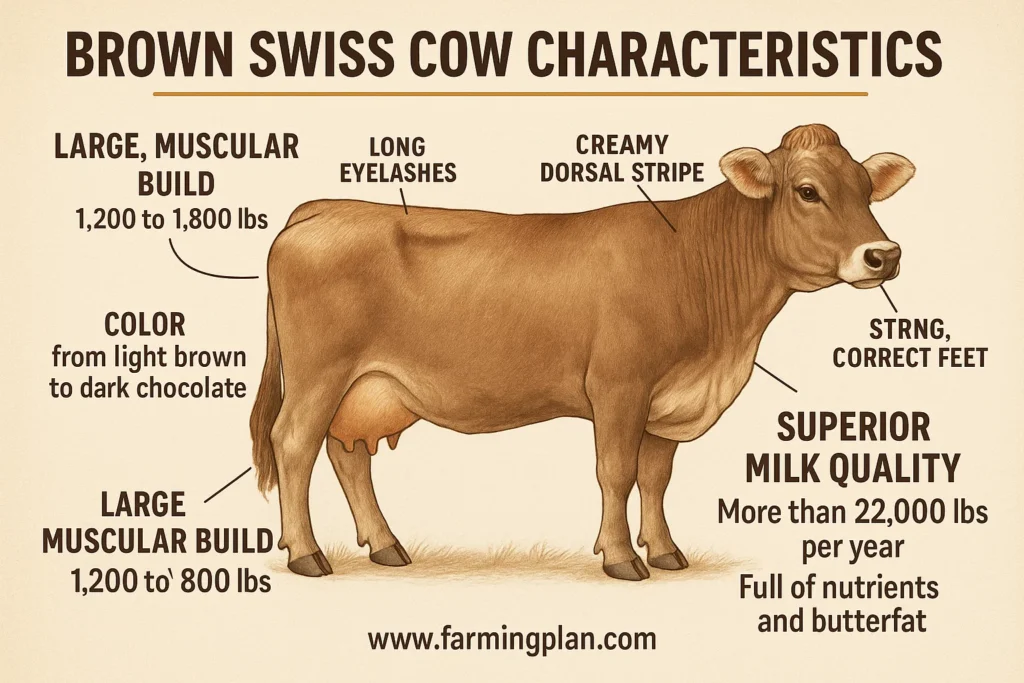
Mostly, what makes them different from other animals is their milk. For cheese makers, the superior quality of Brown Swiss milk is partly owed to its good balance of protein to fat. Most Brown Swiss cows are valued for their milk which totals more than 22,000 pounds over the course of the year. The reason their products are high quality is that their milk is full of nutrients and lots of butterfat. On average, cows kept on farms live past 12 years and continuously support the farm.
Read More: Simmental Cattle: A Breed of Dual-Purpose Cattle
Temperament and Nature of Brown Swiss Cattle
One of my favorite things about working with Brown Swiss cows is their docile temperament. They’re naturally calm, quiet, and gentle—perfect for both beginners and experienced dairy farmers. Their inquisitive nature means they’re easy to train, and I often find them curiously watching me work in the barn. They rarely get spooked, which makes milking and handling a breeze.
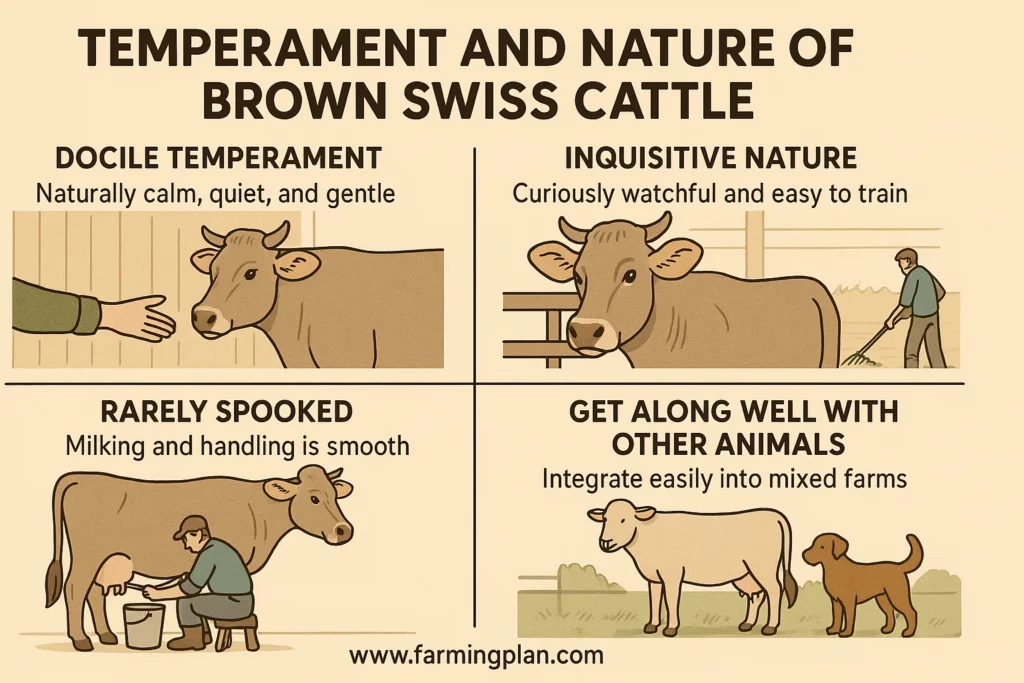
These cows also get along well with other animals. Whether it’s other cattle breeds, sheep, or even farm dogs, Brown Swiss integrate smoothly into a mixed farm environment. Many dairy farmers and animal breeders love them because they’re so easy to manage. If you’re looking for a breed that won’t test your patience, Brown Swiss is the way to go. Their gentle nature isn’t just a bonus—it’s one of their strongest traits.
Read More: Pinzgauer Cattle: Milk & Meat Excellence
Feeding & Nutrition for Brown Swiss Cows
To keep your Brown Swiss cows healthy and productive, you need to focus on balanced nutrition. These cows require a steady diet rich in energy, protein, and fiber. I typically feed mine a mix of alfalfa hay, corn silage, and protein supplements. Clean water should always be available, as high milk producers drink gallons each day.
You’ll want to tailor the diet depending on the cow’s age and production stage. For Brown Swiss calves, I start with quality colostrum followed by a well-balanced starter grain. For lactating cows, I boost calcium and monitor their weight closely to support strong milk yield. Avoid moldy or poor-quality feed, which can affect both milk quality and cow health. A well-fed Brown Swiss won’t just give you more milk—it’ll also live a longer, more productive life.
Purpose and Uses of the Brown Swiss Cow
The Brown Swiss Cow is best known for being a top-tier dairy cow, thanks to its rich, creamy milk. It’s the preferred choice for many cheese markets, especially those that require milk with a high protein-to-fat ratio. But that’s not all—because of their sturdy build, these cows also serve well in beef production once their milking days are over.
Many farms use Brown Swiss as a dual-purpose breed, taking full advantage of both their dairy qualities and beef capabilities. Some small-scale farmers even train them for light draft work due to their strength and calm demeanor. Whether you’re producing butter, cheese, yogurt, or quality beef, Brown Swiss cows offer double utility and consistent performance.
Unique Features of the Brown Swiss Cow
Brown Swiss cows are known for a few standout traits that make them especially valuable on any farm. First, their longevity is impressive—they often stay in the milking herd well into their teenage years. This means fewer replacements and more return on your investment. Their quiet temperament also reduces stress on the farm, making for smoother daily operations.
Another unique feature is their ability to adapt to a wide range of environments. From alpine climates to humid lowlands, Brown Swiss hold up well thanks to their dense skin and strong hooves. Their milk components meet exacting cheese market demands, and their protein ratio is often better than that of other dairy cattle breeds. With such a solid package of traits, it’s no surprise Brown Swiss are in high demand across the world.
Brown Swiss Cows Are Built For Cheese And Chill—Strong, Sweet, And Made For The Hills!
Health Issues & Preventative Care
Brown Swiss cows are generally hardy, but like all animals, they do have a few health concerns. The most common issues include mastitis, hoof problems, and metabolic disorders like milk fever. On my farm, I make hoof trimming and udder checks a regular part of our routine to stay ahead of these issues.
Vaccination is key, especially for young calves. I vaccinate mine early for respiratory and clostridial diseases. I also make sure the housing is dry and well-ventilated to avoid respiratory issues in wet seasons. Prevention always beats treatment, and with regular vet care, clean bedding, and good nutrition, your Brown Swiss cows can enjoy long, productive lives free from major health problems.
Step-by-Step Brown Swiss Cow Farming Guide
Raising Brown Swiss cows is rewarding, but success depends on getting the basics right. From selecting your first heifer to setting up your barn, here’s my tried-and-true guide to starting strong.
Step 1: Choose Healthy Calves or Heifers
Everything starts with good genetics. Whether you’re buying from a local breeder or a livestock auction, look for animals that are alert, have a shiny coat, and show no signs of illness. For calves, clear eyes, a moist nose, and steady breathing are great indicators of health. If you’re starting with a heifer, check for strong legs and a level back—this breed’s solid structure is key to its long productivity. Don’t forget to ask for health records, vaccination history, and parental performance data. Trustworthy breeders will happily provide this and let you inspect their facilities. You want cows from clean, well-run operations that focus on milk quality and longevity.
Step 2: Build a Clean, Weather-Protected Shelter
Brown Swiss cows are hardy, but they still need comfort and shelter. A simple barn with proper ventilation, dry bedding, and protection from wind or extreme sun will keep them healthy. I use straw or wood shavings for bedding and clean the stalls daily to prevent moisture buildup, which can lead to hoof problems. Include fans or open sides in warm climates and windbreaks or heated shelters in colder ones. Space is also crucial—each cow needs enough room to lie down, stand, and walk without crowding. Keep feed and water areas clean and separate to avoid contamination.
Step 3: Create a Daily Feeding Routine
Feeding your cows correctly is one of the most important tasks. Brown Swiss are large-bodied and high-producing, so their diet must support both body condition and milk output. My cows eat a balanced Total Mixed Ration (TMR), including alfalfa hay, corn silage, soybean meal, and necessary minerals. Don’t skip clean water—each cow drinks up to 30 gallons per day! For calves, start with milk replacer or fresh milk, then gradually introduce calf starter feed and hay. Monitor feed intake and watch for changes in behavior or appetite. Adjust rations based on lactation stage, weight, and milk yield.
Step 4: Monitor Health Closely
Healthy cows are productive cows. I perform a daily health check every morning—look for limping, loss of appetite, abnormal manure, or swollen udders. Mastitis can sneak up fast, so always examine the udder during milking. For hoof health, schedule trimming every 6 months or sooner if your cows are in rough terrain. Vaccinate calves early and follow your vet’s recommended protocol for respiratory, reproductive, and clostridial diseases. Keep first aid supplies and medications on hand, and don’t hesitate to call a vet if anything seems off. Prevention is easier (and cheaper) than treatment.
Step 5: Track Milk Production
Monitoring your milk output enables you to decide what’s best for your animals. You can use a paper diary, an electronic table or a farmers app to note how much milk each cow produces every day. As a result, you’ll find out right away if there are any issues with your crops or animals. Many Brown Swiss cows that produce well give 70 to 90 pounds of milk each day.
Should production drop in an unexpected manner, it often means your animals are feeling ill, are stressed or are eating foul-tasting feed. Checking milk includes a measure of butterfat and protein, both vital for making cheese. Tracking your cows on a regular basis guarantees no cow is being held back from helping the herd.
Step 6: Plan for Breeding
To keep your herd going, plan your breeding strategy carefully. Heifers should be bred around 14 to 15 months old, with their first calving ideally at 24 months. Use artificial insemination or natural service with a proven Brown Swiss bull. Select sires with strong records in milk production, udder structure, and disease resistance. Time insemination to the cow’s heat cycle—signs include increased activity, mounting behavior, and vocalization. Post-breeding, watch for heat signs again in 21 days to ensure the cow is pregnant. A vet can confirm pregnancy after 30–45 days.
Step 7: Keep a Calm Environment
Brown Swiss cows have an easygoing nature, but they thrive in low-stress environments. Keep routines consistent—milk at the same time each day, avoid sudden loud noises, and handle them gently. Stress reduces milk yield and affects reproductive success. I play soft music in the barn during milking, and even talk to them during feeding. It sounds funny, but it really builds trust and makes them easier to manage. A quiet, well-run farm is better for the animals and a whole lot more enjoyable for you too.
Expert Tips & Best Practices
After years of working with Brown Swiss, here are some tips I always share. First, always buy from reputable breeders with known dairy strength in their line. Second, invest in a simple milk-recording system to track quality and yield. Third, mix your herd—Brown Swiss blend well with other breeds like Holstein or Jersey for cross-breeding success. If you’re farming for profit, focus on milk components, not just volume. Cheese makers pay more for milk with the right protein-to-fat ratio, which is where Brown Swiss shine. Lastly, join a local or national breed association—they offer training, events, and selling opportunities you don’t want to miss.
Where to Buy Brown Swiss Cows
Finding the right cow starts with choosing a good source. Look for listings on the Brown Swiss Cattle Breeders Association website. You can also check with dairy co-ops, livestock auctions, or local farm networks. If you’re searching online, phrases like “Brown Swiss cow for sale near me” often bring up quality leads. Buy from breeders who provide health records, milk output history, and fertility data. Whether you’re after calves, lactating cows, or breeding bulls, always visit the farm if possible and observe the animals. Trust your gut—and never rush the process. A good cow is an investment that will pay off for years.
FAQ
How much milk does a Brown Swiss cow produce daily?
A healthy Brown Swiss cow can produce around 70–90 pounds of milk per day, depending on her diet and genetics.
Are Brown Swiss cows good for beginners?
Yes, their calm, docile nature makes them ideal for beginners and small farms.
How long do Brown Swiss cows live?
With proper care, Brown Swiss cows can live and produce milk for 12–15 years.
What are Brown Swiss cows known for?
They’re known for high-quality milk with excellent protein-to-fat ratio, long lifespan, and gentle temperament.
Can Brown Swiss cows be used for beef?
Yes, they have solid frames and can be used for beef once their dairy careers end.
Conclusion
The Brown Swiss Cow is more than just a pretty face in the pasture. It’s a hard-working, friendly, and long-living breed that brings real value to any farm. From its superior milk to easygoing personality, this cow is a dream for both new and experienced dairy lovers. Whether you’re looking to build a milking herd or raise a calm, productive animal, the Brown Swiss offers both quality and peace of mind. Now that you’ve got all the know-how, it’s time to bring one home and experience the Swiss dairy difference for yourself.

